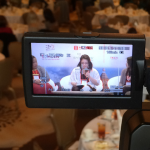 As hoteliers aim to keep meeting clients satisfied during their on-site experiences, they’re spending a significant portion of time thinking about a surprising part of the group: attendees who will never set foot on the property. “Virtual meetings are the future of what people are looking to do when they cannot attend in person,” said Devin Rose, virtual events specialist for PSAV. “We’ve seen a big surge in clients requesting the ability to broadcast presentations from remote locations.”
As hoteliers aim to keep meeting clients satisfied during their on-site experiences, they’re spending a significant portion of time thinking about a surprising part of the group: attendees who will never set foot on the property. “Virtual meetings are the future of what people are looking to do when they cannot attend in person,” said Devin Rose, virtual events specialist for PSAV. “We’ve seen a big surge in clients requesting the ability to broadcast presentations from remote locations.”
Attendees are making requests to participate, too. A 2014 American Express Meetings & Events survey found that 63 percent would attend more meetings and events virtually if the option were available. And while in the past, Rose and his team would have to perform rigorous testing to ensure a property’s network could accommodate a virtual component, today a majority of hotels regularly upgrade their infrastructures. “It’s getting much easier and faster to say, ‘Yes, we can do the videoconference here,’” Rose said.
As virtual technology advances, small-group videoconferencing is only the beginning. Hotels around the world are investing in enhancements to meet the growing demands of online meetings.
THE TELEPRESENCE TABLE
The Westin St. Francis in San Francisco partnered with Cisco to offer a full telepresence suite, with screens that deliver life-size imagery of all meeting participants. “This is a way to make the hotel a much more efficient place to do business,” said Astrid Gintz, senior marketing manager for Cisco, “while still delivering a level of comfort and rapport that used to only be available in a face-to-face setting.”
This type of telepresence suite is designed to deliver business-level AV, according to Gintz, without the delay issues or privacy concerns commonly associated with consumer offerings like Skype or FaceTime. “You don’t have to worry about finding the right camera angle, and you don’t have to worry about the security of the information in the meeting, either,” Gintz said. “Encryption keeps the content of the meeting confidential.”
MR. ROBOTO
“We’ve turned something you would normally think of as science fiction into reality,” Youssef Saleh, senior vice president and general manager of the remote presence business unit for iRobot, said of a pilot program at the Hilton McLean Tysons Corner in Virginia. The property is testing out Ava 500, a roving robot with videoconferencing capabilities and autonomous navigational skills that allow it to act as an in-person surrogate for a remote meeting attendee. When the Red Cross hosted a gala event at the Hilton, Ava 500 helped presenters in Kuwait participate. “They used Ava 500 to act as if they were there at the hotel,” Saleh said.
Cindy Patton, senior director of product development for Hilton Worldwide, sees a range of applications for Ava 500 at meetings and events. “Ava could be a real-time translator for events with a diverse group of attendees, or could help facilitate VIP appearances, like enabling a CEO to join the meeting from an off-site location,” Patton said. “Since attendees can dial-in to the robot remotely and make their face the face of the robot, as well as manipulate the robot’s movements to interact with attendees in real time, we’re able to facilitate face-to-face interactions through the technology.”
SIMPLIFIED SITE VISITS
Another potential application for Ava 500: eliminating some site visits. At the DoubleTree by Hilton Boston–Bedford Glen in Bedford, Massachusetts, the sales team is using the technology to showcase the property to potential clients who are unable to visit in person. “This is a powerful, interactive tool that lets meeting planners experience the service level at the hotel,” said Jennifer Thorn, the DoubleTree’s interim director of sales and marketing. “I’m really optimistic that it will lead to an increase in bookings and revenue as planners have a chance to discover the property before ever traveling to get there.”
MORE BANDWIDTH
Virtual solutions in hotels vary, but they all share at least one trait: the need for robust connectivity. Michelle Klein, senior marketing manager at the JW Marriott Indianapolis, says her property recently made a big investment in technology. “We installed new high-density access points that allow 500 users per device,” Klein said. “Our older technology only allowed between 50 and 75 users.” The JW Indy also increased its main bandwidth from 250MB to 1GB, which can support approximately 5,000 FaceTime users at one time.
Other properties are taking similar steps. A recent report from the NYU School of Professional Studies found that the U.S. hotel industry spent $6.4 billion on capital expenditures in 2015, including significant investments in AV equipment for meeting and event rooms. As hotels make upgrades and remote attendees log in, meeting planners must dedicate additional time to understanding how they want to use that technology. “Know what your needs are and how you intend to connect attendees,” Rose said. “That information plays a critical role in the success of the event.”



